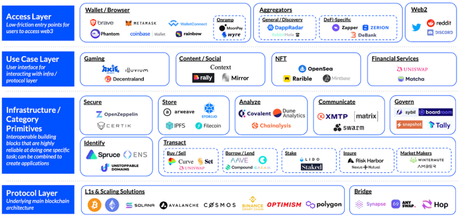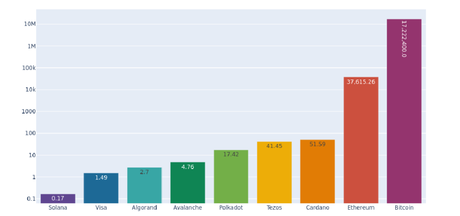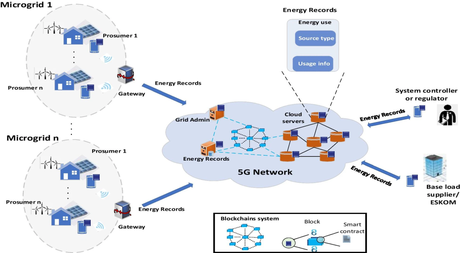Basically, all blockchains got a negative image since the news that mining bitcoins consumes as much energy as a small country. Sure, it’s a fact that a Bitcoin transaction can power a household for more than 70 days in a row. But with the development of new cryptocurrencies and new consensus mechanisms, it was shown that not all blockchains are energy guzzlers. Because of that, can the use of blockchains fit into the concept of sustainability and with this, also have something positive?
Understanding The Problem Of The Blockchain – The Tech Stack
Understanding why Web3 (also called Web 3.0) applications consume so much energy and power, we need to deal with the tech stack first. Web3 has four layers:
1) Protocol layer (base layer)
2) Infrastructure layer
3) Use case layer
4) Access Layer

Protocol layer
At the bottom of the Web3 stack is what’s known as the protocol layer. This is the basis of a blockchain architecture everything else is built on. And this layer encompasses the main problem because it takes the most energy within the whole Web3 construct. The reason for this is primarily the way the transactions are processed and what consensus mechanism the particular blockchain uses. This applies, in particular, to the so-called Proof-of-Work mechanism. More on that is below.
Infrastructure layer
The infrastructure layer builds on the protocol layer and is designed to perform individual tasks in the Web 3.0 environment. These tools enable many features like a smart contract audit, data storage, communication protocols, data analysis platforms, DAO governance tools, etc. For the end user, these technologies don’t necessarily create direct value, but for Web3 developers, they are an important puzzle for creating applications for the users.
Use case layer
The use case layer is the interface for the interaction between the blockchain and the users. Just think of a gaming environment like Decentraland or The Sandbox. For these virtual worlds to work, users need blockchain-based tokens and NFTs. Players must be able to exchange their cryptocurrencies stored on the blockchain for NFTs to dress up their avatars or to get tokens to participate in trades in the Metaverse. This is where technologies like Uniswap can connect gaming and NFT spheres of this tier.
Access Layer
The access layer sits on the top of the whole structure and is an entry point to the Web3 stack. This layer includes, for example, all the crypto wallets required to access Web 3.0. But also so-called onramps (special web services) are also located in the access layer.
Consensus Mechanisms Of Blockchain And Sustainability
There are basically two well-established consensus mechanisms that most blockchains use to verify a transaction: Proof-of-Work (used by Bitcoin and former Ethereum) and Proof-of-Stake (used by Terra, Cardano, or new Ethereum). There are also some other mechanisms that are not as common, such as Proof-of-Identity (PoI), Proof-of-Authority (PoA), or Proof-of-History (PoH).
The proof-of-work mechanism is based on complex tasks that have to be solved by so-called “miners” who validate the transactions. In such a system, the participating computer nodes compete with each other to produce cryptographic hashes that meet a level of complexity specified by the network. To ensure security, this level of complexity is kept high enough to prevent anyone from attacking the network.
However, in order to solve as many search puzzles as quickly as possible, and due to the increasing popularity of Bitcoin & Co., large mining farms have been set up in countries with low energy prices such as Kosovo, Norway, and China. But this process is very energy-intensive, and in the past, it used up a lot of resources, including fossil ones.
Change To More Sustainable Blockchains
Energy consumption has been one of the the reasons why Ethereum switched its consensus process from PoW to PoS. By introducing Proof of Stake process, the network can save around 99.95% of its previous energy consumption. But other blockchain providers have also recognized the problem and starting to transform themselves.

For example, open-source initiative Crypto Climate Accord has committed to decarbonizing the global crypto industry. It prioritizes climate protection and supports the transition of the entire crypto industry to net-zero greenhouse gas emissions by 2040. There are also large companies working on solutions. For example, Blockstream cooperates with Tesla and Block (formerly Square) to build a solar-powered, sustainable mining center. There are also energy-efficient blockchains like Cardano, Tezos, and KodaDot.
Algorand has also committed to becoming the world’s greenest blockchain and being carbon neutral (using a consensus mechanism called Pure PoS) in collaboration with, for example, ClimateTrade.
Polygon announced in a commitment statement that it will spend over $20 million in 2022 to go carbon negative.
At the same time, it should be emphasized that the energy mix is also relevant for evaluation of blockchains. Many projects are already transitioning to using only renewable energy sources. Occasionally, however, this leads to negative, unintended consequences for the local population. In some countries like China, for example, this can lead to problems with water usage and access for the people.
Sustainable Blockchain Use Cases
The proof-of-work concept and its very high energy consumption is actually the major disadvantage of some blockchains. But once this problem is solved, can blockchains help to accelerate sustainable transformation? Let us take a look at some examples where it might be possible.
Some potential use cases for the use of blockchain and sustainability can be
- Peer-to-peer energy trading (Smart Grid)
- Market platforms for renewable energy certificates
- Micro-leasing marketplaces
- Trading in emission permits
- Digital measurement, reporting, and verification (MRV)
- Issuance of green bonds where greenwashing by the issuer is not possible
- “Sustainability accounting” through automated control of ESG data
- The tracking of the use of funds from donations and development aid as well as the prevention of state corruption
- The tamper-proof storage of digital identities
Many of these solutions combine several innovative technologies like blockchain, artificial intelligence, and the Internet of Things with affordable renewable energy generation, and energy storage systems.
Of course, it sounds great that it’s possible to implement different use cases on the blockchain. But how is it possible to get data from the “real world” onto the blockchain? And this is quite big challenge to solve.
There is already a solution available, with so-called “oracles”. An oracle is a connection between blockchain (smart contract) and data from the real world such as weather reports, humidity, machine states, etc. The data is often collected via sensors, and an oracle acts as an on-chain API that can be queried to get information for smart contracts.
Still, there is a problem with oracles. The quality of the results processed using a blockchain depends on the quality of the data fed into the blockchain via oracles. But data from third-party sources has significant impact on the execution of a smart contract, overriding its trustless nature as part of a decentralized network. That’s why you always have to ask yourself where the data comes from and how trustworthy it is.
Blockchain And Sustainability – Let’s Dig Deeper
Let’s check two of described examples in detail:
Peer-to-peer Energy Trading (Smart Grid)

Blockchains can become a major innovation in the energy sector. At least blockchain technology has arrived here in the form of pilot projects. This is partial because of their ability to support decentralized, clean energy policies without relying on traditional centralized authorities. The term smart grid refers to consumers who are both generators and consumers of electricity.
As the demand for reducing the carbon footprint of conventional energy systems is increasing, blockchain can enable peer-to-peer energy exchange within microgrids. This could be done using what is known as a Blockchain Distributed Energy Network (BDEN), and it can lead to increased transparency, competition, cost savings, and efficiency.
The main benefit of such a blockchain-powered model is a private micro-grid managed locally by its participants. Blockchain traceability allows energy consumers to reflect on their own environmental footprint and encourage local energy production, which can reduce large-scale energy losses.
By having more control over their energy distribution, households could have more incentive to ration their consumption and thus optimize the collective use of sustainably generated energy.
Challenges To Be Solved
Before someone starts to cheer, there are some major challenges to be solved before such projects can be adopted by the broad market.
Because in the regulated energy network, there is a lack of use cases in which blockchain technology provides real added value compared to established processes. Intelligent measuring systems are required for large number of planned applications in the competitive value-added stages, which are not yet widely spread today.
Key criterion for the success of this technology is likely to be the interoperability that has yet to be created between individual blockchain applications, blockchains, and existing industrial processes in the energy industry.
Hence, the quick disruptive changes that the energy industry hopes to get from the blockchain solution will probably not be available in the near future.
Sustainable Supply Chain Management (SSCM)

Sustainability in the supply chain means managing environmental, social, and economic impacts. But also promoting good governance practices throughout the lifecycle of a product or service. Blockchain is an opportunity for outdated systems as it enables all supply chain actors to record their activities in a single data set.
The negative environmental impacts of supply chains have been known for years. In 2016, it was reported that the supply chains of consumer packaged goods (CPG) companies are responsible for up to 90% of environmental damage. This rating far exceeds the impact of all other corporate activities. Therefore, the key players in the commodity industry are trying to manage the problems in the supply chain by introducing more sustainable solutions.
How can blockchain help in this case? Blockchains can build trust between different actors through encryption technologies combined with various consensus mechanisms to validate new transactions. An intermediary responsible for executing, logging, and securing transactions is no longer required.
For example, to trace a sack of cobalt, a block of information with a unique identifier, such as a QR code, can be added at each stage of the supply chain. Similarly, metals and minerals can be traced back via a unique label based on information about their chemical compounds. But it can also be applied to daily consumer goods. With blockchain technology, the packaging could be scanned with a smartphone to trace the product’s journey from origin to the consumer.
Hence, blockchain integration with Sustainable Supply Chain Management (SSCM) can enable a higher level of consumer awareness. Product integrity issues are legitimate concerns in a traditional supply chain due to their transparency and traceability issues. But of course, someone has to establish such a process…
Blockchain and Sustainability – Conclusion
Blockchain technology has a bad reputation for sustainability because of the high energy consumption of Bitcoin and old Ethereum. In principle, however, blockchain technologies can help implement the concept of sustainability, especially since many DLT solutions are not associated with high energy consumption.
In principle, blockchain technology is compatible with ESG criteria. If the energy consumption of blockchains came from 100% sustainable energy – which has not usually been the case so far – this technology would be compatible with the ESG criterion “Environment”.
With regard to the other two ESG criteria, social and governance, a more positive assessment can already be made. On the one hand, the goal of blockchain technology has always been to democratize the financial sector and to generate greater financial inclusion, especially in emerging countries.
Due to the decentralized approach, blockchain technology is, in principle ESG compatible with the criterion governance. A completely different question is whether there is actually a high market concentration in mining and in the digital assets held by individual large players.
Social sustainability is a component of sustainable development, and organizations can achieve sustainability by addressing social issues. Blockchain technology has the potential to do more than just facilitating digital currency transactions. It can create a decentralized system that promotes transparent communication and interactions, reducing information distortion and forgery. This technology can also help monitoring behavior of executives, promote business ethics, and achieve constructive social interactions, contributing to social sustainability.
By implementing of blockchain technology, companies can use smart contracts and improve corporate governance, thus promoting good business ethics and sustainable practices. For instance, in the Middle East, where natural resources such as oil and water play a critical role in social sustainability and sustainable development, investing in IT and related technologies like blockchain can contribute to solve the problem.
Therefore, blockchain and sustainability can indeed go together but there is a lot of work and progress to do.
Subscribe for free to receive new posts and support my work. The subscription will be proceeded via substack.com. There, you can subscribe for free content but also for premium content. Just check it out by clicking the button below! If you would like to publish content on substack, please click here.
SUBSCRIBE TO A NEWSLETTER